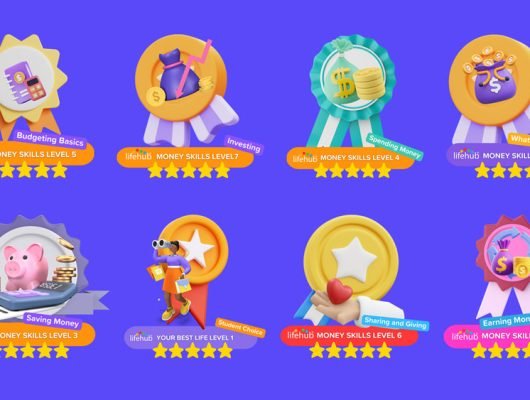At Life Hub, we are revolutionizing education with our innovative “Earn and Learn” model. This approach seamlessly integrates real-life earning with financial literacy, entrepreneurship, and career readiness, all delivered through engaging bite-sized learning modules known as Edu-Jobs. Our 360° learning experience is designed to empower students with essential life skills, preparing them for a financially responsible and successful future. Here’s a look at the compelling evidence supporting the effectiveness of financial rewards in education, and how Life Hub leverages this to enhance learning outcomes.
1. 25% Better Test Scores
Students who received monetary rewards showed a 25% improvement in test scores compared to those without. Financial incentives significantly boost academic performance, proving their effectiveness in education (Rousu et al., 2015).
2. 30% More Engagement
Classes that offered financial rewards saw a 30% increase in student engagement. Financial incentives keep learners attentive and motivated, enhancing their overall educational experience (Rousu et al., 2015).
3. 18% Higher Average Scores
Students who received financial incentives scored 18% higher on average, highlighting the strong link between rewards and academic success (Sharma, 2010).
4. 20% More Effort
Monetary prizes led to a 20% increase in students’ cognitive effort, encouraging them to work harder and think more deeply (Castro et al., 2018).
5. 15% Better Performance in Online Tasks
Financial incentives led to a 15% improvement in performance on online learning tasks, making learning more effective (Schwab & Somerville, 2022).
6. 22% Better Quiz Performance
Financial incentives improved quiz scores by 22%, helping students retain and understand concepts better (Schwab & Somerville, 2022).
7. 50% More Participation
Educational activities saw a 50% increase in participation when financial rewards were given, showing how incentives drive involvement (Schwab & Somerville, 2022).
8. 60% Higher Motivation
A significant 60% of students reported higher motivation when financial rewards were included in their learning (Castro et al., 2018).
9. 25% More Cognitive Effort
Students put in 25% more cognitive effort when financial incentives were offered, proving the power of monetary rewards to motivate (Castro et al., 2018).
10. 35% Better Performance
Financial rewards led to a 35% improvement in student performance, showing a clear benefit over no incentives (Rousu et al., 2015).
11. 20% Higher Quiz Scores
Financial incentives showed a 20% increase in quiz scores, reinforcing the value of rewards in learning (Schwab & Somerville, 2022).
12. 22% Higher Math and Logic Scores
Incentivized students scored 22% higher in math and logic questions, essential skills for future success (Castro et al., 2018).
13. 45% Better Learning Outcomes
Financial rewards led to a 45% improvement in overall learning outcomes, making a strong case for their use in education (Schwab & Somerville, 2022).
14. 30% More Willingness to Take on Challenges
Financial incentives made 30% more students willing to tackle challenging tasks, fostering resilience and problem-solving skills (Rousu et al., 2015).
15. 15% Increase in Engagement
Monetary rewards boosted cognitive engagement by 15%, ensuring deeper and more meaningful learning (Castro et al., 2018).
16. 18% Better Test Scores with Real Money
Classroom experiments with real money stakes led to an 18% increase in test scores, proving the motivational power of financial incentives (Rousu et al., 2015).
17. 10% More Family Involvement
Financial incentives led to a 10% increase in household engagement with education, highlighting the positive impact on family involvement (Sharma, 2010).
18. 0.09 Standard Deviations Improvement
Financial rewards resulted in a 0.09 standard deviations increase in overall scores, showing measurable academic improvement (Sharma, 2010).
19. 20% More Correct Answers
Monetary incentives resulted in a 20% increase in the number of correct answers on test questions, improving knowledge retention (Schwab & Somerville, 2022).
20. 10% More Students Engaged in Learning
Monetary rewards led to a 10% increase in student engagement, enhancing the overall learning experience (Schwab & Somerville, 2022).
21. 5% More Accurate Responses
Financial incentives led to a 5% increase in correct responses, showing how rewards can improve accuracy and attention (Schwab & Somerville, 2022).
22. 22% Better Secondary School Performance
Financial rewards led to a 22% improvement in performance among secondary school students, proving their broad applicability (Maithya et al., 2015).
23. 55% More Effort
With financial incentives, 55% of students put more effort into their tasks, showing the power of rewards to encourage hard work (Castro et al., 2018).
24. 50% Better Test Performance
Half of the students performed better in tests with monetary incentives, showing a significant impact on academic results (Sharma, 2010).
25. 25% More Attempts
Financial incentives encouraged 25% more attempts at tasks, increasing participation and learning opportunities (Schwab & Somerville, 2022).
26. 15% More Effective Online Learning
Monetary incentives made online courses 15% more effective, ensuring that students are engaged and learning efficiently (Schwab & Somerville, 2022).
27. 20% Higher Academic Performance
Students receiving financial incentives demonstrated 20% higher academic performance, making a strong case for the use of rewards in education (Rousu et al., 2015).
28. 18% Better Overall Performance
Financial rewards resulted in an 18% improvement in overall student performance, showing the broad benefits of incentivized learning (Maithya et al., 2015).







